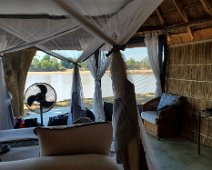
Our final camp was Mchenja which is the local name for ebony. The camp is built near a grove of ebony. Here is a view of the South Luangwa River from our tent/hut.

The bath was located inside the tent and chairs were stationed just outside on the porch so you could sit and relax while enjoying your beautiful surroundings.
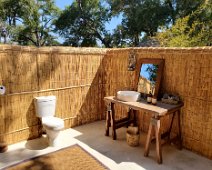
The outdoor bath accommodation was a bit exciting at times if a frog decided to jump on you as you entered.
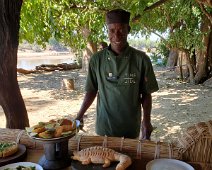
Meals were just as delicious here as at every other camp we visited. Our chef, Jones, served us wonderful meals like this lunch. He even made fun items like this "crocodile" loaf of bread.
This Baobab tree has a Red-billed Buffalo Weaver nest in it. A typical male red-billed buffalo-weaver nest will have up to eight nest chambers each to house numerous females.
Lilac Breasted Roller - they perch conspicuously at the tops of trees, poles, or other high vantage points from where they can spot insects, lizards, or other prey moving about on the ground.
The Thornicroft's giraffe's previous specific name, camelopardalis, means "leopard-patterned camel".
Unlike most mammals giraffes walk using both legs from the same side of the body simultaneously. When they gallop they move both fore legs and both hind legs together.
The two knobs on their head are called ossicones. Unlike antlers on deer or horns on bovids, ossicones are permanently covered by hair and never shed.
Yellow-billed storks are adaptive and intelligent. They have a fishing technique of using one foot to stir up the water to flush out prey.
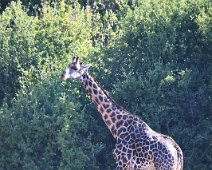
Giraffe are herbivores and only eat plants. Their favorite grub is the acacia tree, and they use their long necks to reach the leaves and buds in the treetops. Their long tongues (which grow to a whopping 21 inches!) also help them pull down leaves growing way up high.
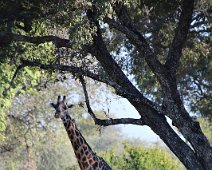
To see who is stronger, males (called bulls) fight by butting their long necks and heads. This is known as “necking“. These fights aren’t usually dangerous, and end when one bull admits defeat and walks away.
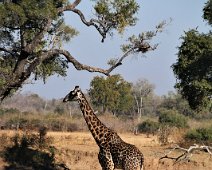
A giraffe’s head is 7 feet away from it’s heart, which makes for a very difficult challenge to pump blood to the brain! They have a relatively small heart yet extremely high blood pressure (that’s twice the blood pressure of humans), and a heart beat up to 170 times per minute (also twice as much as humans).
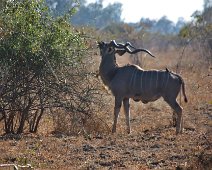
Kudu horns have spirals, which allow males to spar by interlocking horns. The males then proceed to shove and twist until one opponent is knocked off balance and thrown down. Some reports show male kudus found with locked horns, even in death.
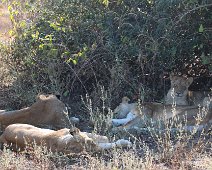
This is the "Hollywood" pride of female lions. We found them at mid-day so they were fully in sleep mode.
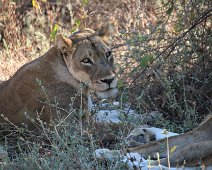
This is the alpha female of the pack. She has a radio collar around her neck. This lets the scientists and park staff track the entire pride as they will all move where she goes.
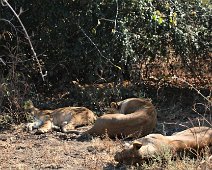
Female lions will bond for life. This means that any female cubs that grow up together are likely to still be friends later in life. It’s rare that mother and daughter lions will ever split up.
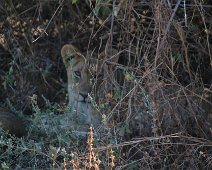
The lions had come across a group or lion researchers the night before we saw them. The researchers had parked their vehicle for the night and gone to sleep on the roof of the vehicle. While they slept the pride ransacked the items around their vehicle. As we watched, this cub began chewing on a flip-flop that we suspect came from that encounter.
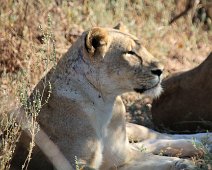
After watching for about an hour our guide, Jon, said we would move on, but, we would return to see them in the evening.
Tea time in the savannah. For tea time and "sundowners" the vehicles were equipped with a grate that folded up from the safari grill on the front of the vehicle. The our guide and tracker (Jon and Pilaf) would put a table cloth over it and set our the goodies.
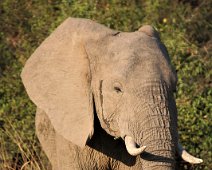
The tusks of an elephant are modified incisors that grow throughout an elephant’s lifetime. An adult male’s tusks grow about 7 inches a year.
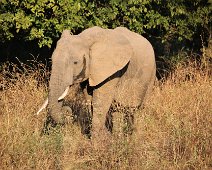
Elephants have one temporal gland on each side of the head between the eye and the ear. The temporal gland is a large gland, much like a sweat gland, that sometimes produces a secretion that trickles down the side of the face. In female elephants, these glands may become active when the animal gets very excited. In male elephants, the temporal glands are active when the male is in “musth”, which is a condition very much like “rut” in a deer.
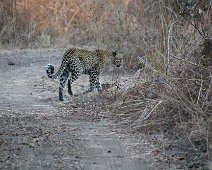
He wandered up the road in front of us, then turned and moved into the underbrush where he was no longer visible.
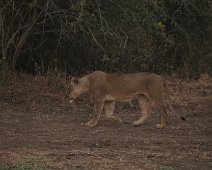
We headed back now to see the lion pride we watched earlier in the day. As we arrived this female that had just been out on an unsuccessful chase was returning to the pride.
The strategy of lionesses is unique. They stalk their prey for miles, hide in bush and ambush eventually.
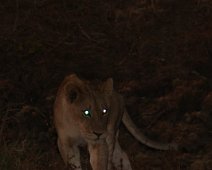
After three years of age, male cubs are expelled from the pride. These male cubs go to another kingdom to take over another pride. The battle takes place between the intruder and main lion of pride. If the intruder wins the battle, he kills all the cubs and mates with lionesses and sews the seeds of his own bloodline.
The lion’s tongue is made up of tiny spines called Papillae. It helps lions scrape meat from bones and dirt from fur. Apart from it, its tongue really helps lion drink water. Lions can go without water for about 2 weeks.
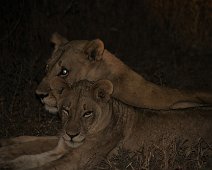
There are two prides in the area of our camp. The Mamba pride, named after the Mamba River that they are near and this pride, the Hollywood pride named because they were more beautiful and were not full of scars.
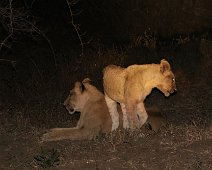
Only one in five cubs survives in the wild. They are killed by other predators; especially by hyenas and wild dogs or they starve to death.
Lion is the only cat that has a tasseled tail. When the lion becomes 5 or 7 months older, it starts to appear.
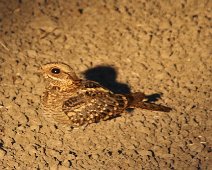
Gabon Nightjar - Like other nocturnal birds, nightjars have exceptionally large eyes containing a high concentration of light sensitive rods which assist them with hunting in low light conditions.
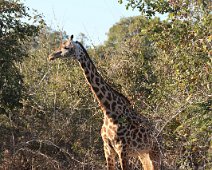
Our last full day of safari was to start with a walking safari. However, on the way to our stop we saw this splendid Thornicroft Giraffe.
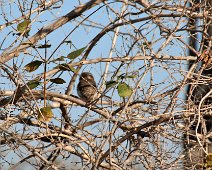
Pearl Spotted Owlet, one of Southern Africa’s smallest owls, have “mock” eyes at the back of its head, which confuses predators.
Antlion - The antlion’s summer season residence is a conical melancholy or “pit” about an inch deep and an inch or two in diameter. He expertly engineers a pit in tender sand and friable, dry soils.
This is called a "Sausage Tree". Ken found these trees irresistible. But it turns out this tree has been used for medicinal purposes for thousands of years.
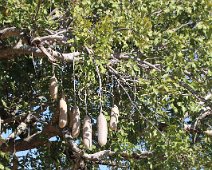
This is the fruit of the sausage tree. It can grow to a formidable size – up to three feet in length – and weigh up to 30 lbs. It is a woody berry, containing seeds and pulpy texture. In its raw form, the sausage tree fruit is poisonous to humans, so don’t try to eat it!
Here Sharon and our guide, Jon, and tracker, Pilaf, pause during our walk with an elephant under the distant trees.
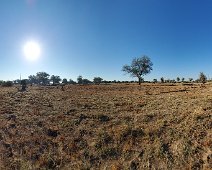
A view of the open plains with some distinct "Hippo Highways" visible on the ground. Our guide called them that because hippos use the same path over and over again each night as they leave the water to forage for food. Trackers use them to determine the direction back to water in case they get lost.
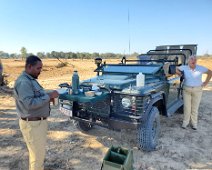
After returning to our vehicle, Jon fixed us hot coffee or tea and we enjoyed some muffins in the great African outdoors.
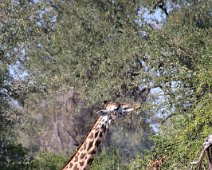
This was our last chance to observe a Thornicroft Giraffe. This one was snagging a bite from a nearby tree.
This giraffe has some additional company. There are numerous Red-billed Oxpeckers riding on her neck and back. These birds search the giraffe for parasites like ticks to eat.
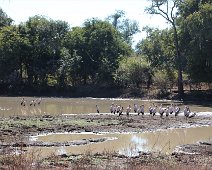
Yellow Billed Storks have one of the fastest swallowing reflexes known, enabling them to catch moving prey in water very quickly. They can snap their beaks shut in just 0.025 seconds.
These Yellow Billed Stork were flying in circles above us as we drove and looked like a choreographed dance in the sky.
Bushbuck - Female - When frightened, bushbuck can freeze or lay to the ground and wait for the danger to pass.
Vervet monkeys are playful creatures. Young monkeys like to wrestle and test their own stability by pushing each other from the branches.
African buffalo is well known for its exceptional memory. It will recognize a person (such as hunters) that hurt it in the past and it will attack it at their next encounter.
When faced with predators, animals of the herd form a circle around the young, old or weak animals, exposing their large and sharp horns toward the predators. This barrier is very effective and prevents predators to reach the animals that are not strong enough to fight.
The horns of the African buffalo are an excellent indication of age and gender. The females and young males do not have the hard shielding that protects the base of the skull in large adult males.
Herds of African buffalos appear to have a unique way of deciding in which direction to move: they vote on it! When the herd is ready to move on after resting, individuals start to stand up and face the direction in which they wish to move. Eventually, when enough members have ‘voted’, the dominant female leads the herd off in the direction that most of the individuals have faced.
African buffalo are always within a day's walk of a water source. This is especially true in the dry season when they are eating dried grasses.
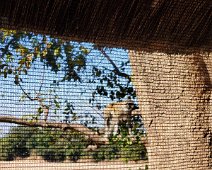
During our afternoon siesta, this monkey came to spy on us. So, we decided to play peek-a-boo from one side of the tree to the other.

Our last night in Africa was a sight to behold. The moon and stars twinkled in a perfectly clear sky.
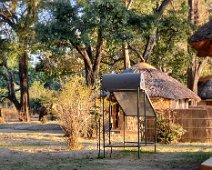
In the morning we arose to have breakfast before leaving for the airport. Some elephants decided to see us off right in camp.
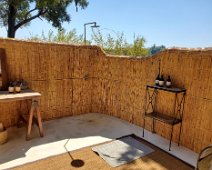


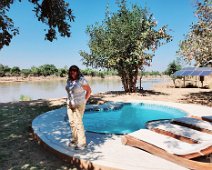

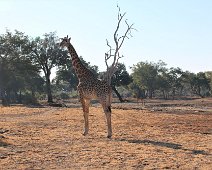

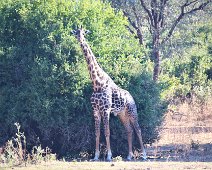

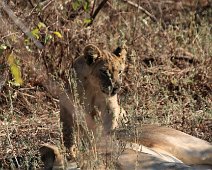



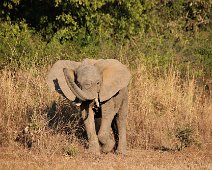
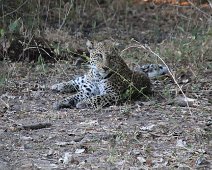
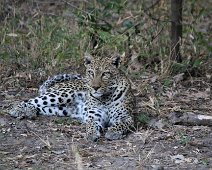
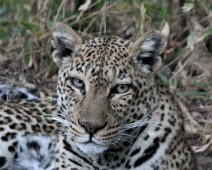
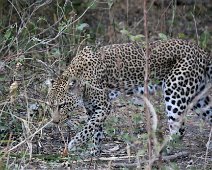
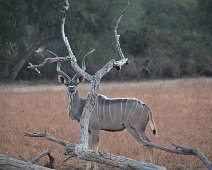
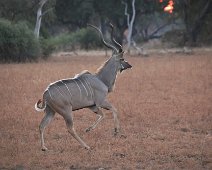
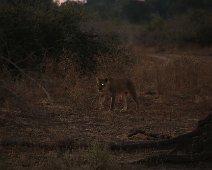
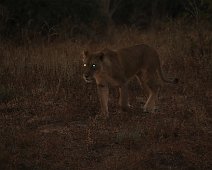

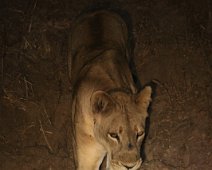
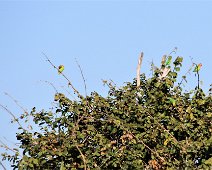
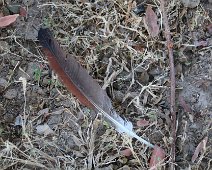
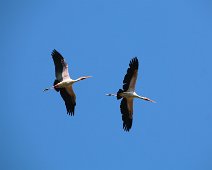
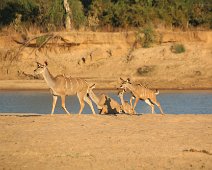
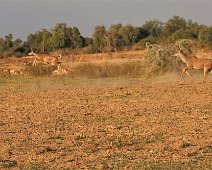
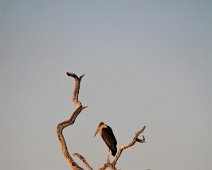
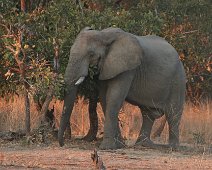





Zambia 4 - Mchenja